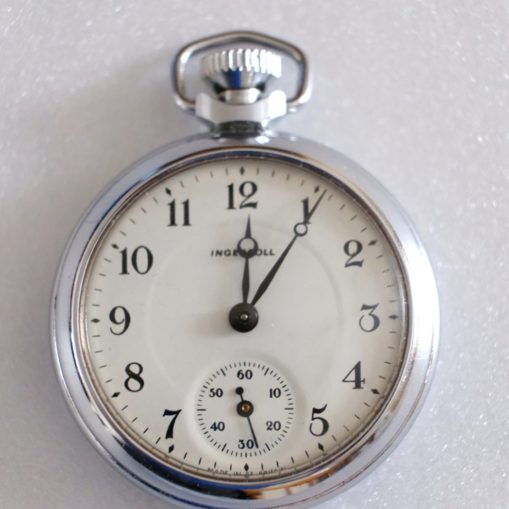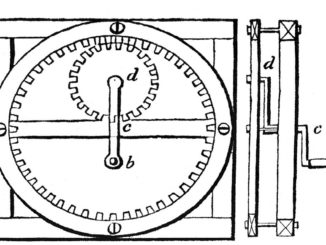This is the story of a watch. A plain, simple, pocket watch.
Probably bought in the early 1940’s for three Half-Crowns (7/6, or in “New Money”, 37.5p) from a Woolworth or a High Street Jewellers.
There’s nothing much special about it, it’s in a Chrome case, has a fairly plain white face, is hand wound – no automatic winding for this watch – and was made in Great Britain, by Ingersoll.
Like I said, nothing much special about it, except, it was Dad’s watch.
He took it to work with him, in a round Zubes tin, padded in cotton wool.
I can still to this day hear his little mantra, his routine, said to make sure he never forgot anything:- “Bait, Bottle, ‘Baccy, Tabs, Knife, Watch, Matches”.
Dad was Deputy Shotfirer at the local colliery. The title doesn’t describe his job accurately, by its sound it would appear he was subservient to the Shotfirer, his Deputy (like a Deputy Sheriff).
Nothing could be further from the truth. The title meant that Underground he was the Deputy for the Colliery Manager, and his word was law. In fact, Underground, the Colliery Manager deferred to my Dad on all things pertaining to safety, in operations and in equipment.
In addition to him being God’s representative Underground he was also charged with, and skilled at, blowing things up.
Shot firing, in fact.
A shotfirer goes onto a coal face, supervises the drilling of holes, about an inch in diameter, sometimes as much as 6 feet deep, packs them with explosives (Dynamite usually, but if there was stone to be removed he sometimes used an early version of C4). He would then prime the explosive by putting in a detonator (or “Det” in the slang), attach wires, ram it to the end of the hole with a Shotfirers Stick, then plug the hole with clay.
A coal face can be as much as 50 – 60 yards long, or just 10 yards.
The process is the same, mark where the holes are to be drilled, poke the charge up the hole, prime and then plug. Repeat this process as many times as needed, a 50 yard face could need as many as 100 “shots” to bring it down.
All of the wire ends would then be connected to the running wire, in parallel, and the running wire connected to the Detonator box, or “Det box”. This is a hand cranked generator which stores an electric charge in a capacitor, so that when the switch is thrown the current fires the detonators which then ignite the explosive charges.
This is, of course, a dangerous thing to do, even above ground. Underground, with a ceiling height of 6 feet, at best, and usually much less, it is VERY dangerous.
The Det box is nothing like you see in Western movies, there is no plunger. It more resembles an old fashioned wind up gramophone.
There is a 2 switch safety feature, each hand has to press down a switch for the current to flow.
This is done, obviously, from a distance, the coal face is cleared of men and obstructions, no one wants to be smacked in the face by a pit prop – a 6 inch diameter pine log, as long as the roof is high.
The call goes up to bank – “Sound the siren” – the Klaxon gives 3 blasts, the shotfirer shouts “All Clear?”.
If there’s no reply he shouts “Firing in.. 3…2..1..Fire” and fires the charge.
After the big bang it is his job to go back along the coal face and check that every charge fired, if there was a misfire he had to render it safe. A dangerous task, indeed.
Dad went to work one morning, on “Earlies” 6 ’til 2, as usual.
Checking the roster and the report from the night shift he saw that there had been a firing during the night and that a face had been dropped.
He went down to check it and to see that is was safe, it should have been the task of the night shift shotfirer but Dad always double checked.
Everything looked normal, there was the usual 50 yard heap of coal left by the explosion, ready to be loaded by the day shift “putters” – men who loaded the coal onto conveyor belts or into “tubs” – little coal wagons on a miniature railway.
As he made his way along he noticed a length of wire sticking out of the coal. This was unusual, the wire is usually blown into tiny pieces by the force of the blast, sometimes a short length can be driven into a pit prop like a nail by the force.
The length of wire usually denoted a misfire, and as he went to move some coal surrounding it, it went off.
The resulting explosion blew him back 30 feet, collapsed both his lungs, and stunned him.
They got him to bank, stretchered him away to hospital and operated on him to save his life.
One lung was completely ruined and had to be removed, the other they managed to save, but it was touch and go. He spent 2 years in hospital, having several operations and finally recuperating in one of the Cottage Hospitals locally.
To get back to the watch! Phew!!
Well, the watch was in Dad’s waistcoat pocket (as Deputy Shotfirer, second only to God, he had an image to uphold) and consequently was blown 30 feet with Dad.
It was protected by the Zubes tin and the cotton wool padding, but had stopped dead by the blast, at the time of the blast (very Hercule Poirot).
Until recently the watch sat in my bedside cabinet, not going, just as a reminder of what it went through, and what Dad suffered.
Then, recently, a family member took up watch repairing as a hobby and kindly got Dad’s old watch running again.
I wind it every night when I go to bed, and think of Dad while I’m doing it.
Dad died in 1984, he worked in very light jobs for a while, but when the mines closed Dad had to retire, prematurely.
He hated not being able to “pull his weight”, but bore it with the stoicism and fortitude that I would expect of him.
He got the grand total of £333 for his injury.

© Grimy Miner 2021
Dad, this is your watch.
© Grimy Miner, Going Postal 2021
The Goodnight Vienna Audio file
Audio Player



